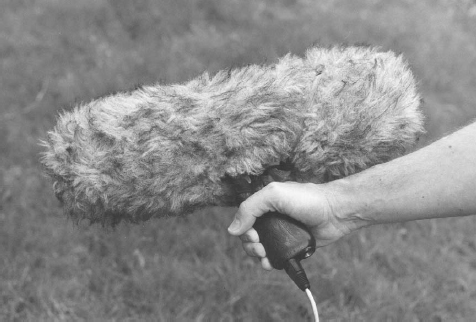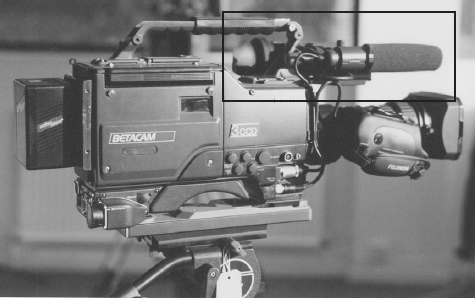18 Single person operation: specific location scenarios
Walking and talking
Once your reporter is on the move, there's little choice other than a radio mic to avoid cable hazards. Assuming it's a clip mic, when he/she walks around, you have no control over its relationship to other sound sources, since it's in a fixed position, clipped to their clothing. So, if, for example, they move close to workmen using power tools or pneumatic drills, you cannot adjust the balance of their speech relative to the background noise.
This will almost certainly prove intolerable unless the source of the noise is in vision, which at least helps to explain its aural presence. But you will still be unable to adjust the balance between voice level and noise. However, it's a human trait to RAISE YOUR VOICE when trying to make yourself heard over a very loud noise. A professional reporter will invariably do this, which goes some way to overcoming the problem for you.
In these circumstances, you'll need to adjust the overall channel level which, if the camcorder is on your shoulder, will be on the front of the body/viewfinder. However, if the camcorder is on a tripod, you have the choice between the front control or the main channel gain on the recorder (see also Section 5, Camcorder: sound levels). The choice is purely personal, and depends in the main as to which is least likely to affect the shot, i.e. can you adjust the control without wobbling the camera?
With luck, that should provide you with acceptable sound, but the inexperienced/shy/nervous reporter may not automatically raise their voice. If this is the case, even riding the level control will almost certainly prove insufficient, and a retake is your only solution. Attempt to re-position the reporter to increase their distance from the source of the problem. Better still, try and persuade them that the piece works better in a static position, as far away from the noise as possible!
Press conference
A well-organized press conference is relatively easy to cover. A line feed from the PA will be available, although you'll probably need to supply your own XLR cable to plug it into your camcorder. (Beware the semi-pro system with an unbalanced output feed, a direct inject box may be necessary, see Section 9, Mics: cables and radio.) You can then either switch the camera mic to the second track, or put a radio mic on your reporter, if they are likely to ask questions at the Q&A.
However, if it's not been well-organized, you may wish to put a radio mic (on a table stand?) on the top table. If you do, you'll need to find out in advance who's going to speak in order to reassure yourself that it's correctly placed; and, from bitter experience, I can tell you that the organizers of these events often get that information wrong!
If there's PA, but no feed supplied (or it's unbalanced and you don't carry a DI box), either place your radio mic in front of a PA loudspeaker, or point your gun mic at one. Check the quality of the sound it produces beforehand, if at all possible, as they can be very variable. You may subsequently find you have to re-position your mic in front of another loudspeaker for acceptable results (it's always best to ascertain how many loudspeakers there are, together with their positions relative to your own operational area).
The worst case scenario is arriving late, after the proceedings have started, only to find that you're left with a poor camera position at the rear of the room, and then having to point a gun mic at the top table from this position as there's no PA. Intrepid operators may gallop up to the top table, bent over double to stay out of shot, and place a radio mic thereupon, but in an overcrowded room, don't count on it!
Phone conversation
Recording a phone conversation will depend on whether or not the phone handset has to be in vision, and whether the call is an ‘actual’ call in realtime, i.e. not staged. For an actual call, if the phone handset is in vision, you will need to conceal the mic and cable, and position the camera to ensure that they remain unseen. Using clear tape, stick the smallest clip mic you have close to the handset's earpiece (Figure 18.1), and secure the cable along the side of the handset away from the camera. Concealing it alongside and/or down the phone cable is problematic if the phone lead is both curly, and of a different colour to your mic cable (Figure 18.2). Providing you don't stretch the phone lead too much on shot, you should be able to get away with the mic lead down the centre of the curly lead. You could also try to ensure that shot-wise the backing behind the phone lead is dark enough to obscure the fact that there's a thinner one inside it!

Figure 18.1 Clip mic taped to telephone handset

Figure 18.2 The mic lead is threaded inside the curly phone lead
Having taped the mic to the earpiece to pick up the incoming audio, you must advise your in-vision reporter not to move their head against the handset/mic capsule combination, in order to avoid unwanted rustling. Shoot the main conversation as wide as possible (depending on production requirements), using a second mic (gun?) for the reporter. Then shoot closer listening shots of them on the phone afterwards from a different angle, with the clip mic removed. You may also wish them to repeat some of the dialogue at the same time.
Depending on the facilities at your location, rather than attaching a mic to the earpiece of the phone that the reporter is holding, you could make use of a second phone on the same line and place a mic close to the handset. However, you must ensure that it is located some distance from your reporter in order to avoid interference. It is also advantageous to surround it with sound-deadening material, if you carry any (or use an on-site cushion or two). This is the preferred option as it does at least make for a visually neater result.
There are devices available ‘over the counter’ in some hi-fi/electrical stores which connect between the wall socket and phone, and produce an audio feed from the incoming phone signal. However, many modern switchboard systems employ digital signals, so this type of device would then only feed you ‘digits’.
There is a fully professional way to record telephone conversations using a telephone balance unit (TBU), but you obviously need to know beforehand (and agree the extra cost of hiring the unit with production). The TBU keeps the line open and has a mic feed, but you need to send a feed of incoming audio to your reporter. This may necessitate the reporter wearing an earpiece with the audio feed, and holding the phone receiver up to their ear to cover it. This set-up may appear overly complicated, but should produce the best (and most reliable) sound from a phone. One point to note, however, it is preferable to originate the call from your end via the TBU, as you don't want it to ring when you're listening (ringing voltage on your input – ouch!).
It is important to understand that for the call to be used/broadcast, the person to whom you are speaking on the other end of the line must be aware that it is being recorded. If they do not, then their privacy must be observed, since an incoming call should not be recorded without them being fully aware of your actions. It is the production team's responsibility to obtain permission to broadcast contributions from any person or source (see also Section 15, Recording for the edit; Copyright) and they normally have to obtain a signed release form to this effect from all participants.
You'll probably gather from all of the foregoing that it is much simpler to stage the conversation, often using a call made by someone in an adjoining room. If you can (and you know that it can be accommodated in post-production) record both ends of the conversation clean, and let the phone frequency distortion be carried out in post-production. This reliably ensures the intelligibility of both ends of the conversation. In a real call, you may have interference on the line/circuit which necessitates a retake. Do not use mobile phones; the interference their operation generates is virtually impossible to overcome. If the call is supposed to be on a mobile (as an in-vision production requirement) it is best to stage it with clean sound as described.
Wind noise
We mentioned wind noise in the first section, and it can severely affect mic choice and placement. The most effective wind gag is the ‘Dougal’ (Figure 18.3), nick-named after the character in the children's serial ‘The Magic Roundabout’. But it needs a reasonable surface area of ‘hair’ around the mic to work efficiently, and so doesn't lend itself to clip mics. It also needs regular grooming, a matted Dougal barely functions. Although a brush is supplied with each from new, better results may be obtained by using a small wire dog brush, available from pet shops.
If you're forced into using personal mics in windy situations, you'll have to protect them under clothing (assuming the sound is still intelligible) and/or use the reporter's body to mask them from the wind. This may compromise the shot, but in this instance the sound is almost certainly the more important element.
If wet, in the pavilion
Rain is another unwelcome element in location recording. Whilst your first thought may be to put up an umbrella, you'll find that the noise of the rain on the fabric is every bit as disconcerting as the sight of a rain swept reporter attempting a PTC. If you can re-position undercover, then that's the ideal solution.
If the rain shows no sign of stopping, and you're out in the middle of nowhere, and the piece has to be recorded at all costs … you need a Plan B. The condenser mics are almost certainly going to complain if they get wet, with hisses, crackles and splats, not dissimilar to certain breakfast cereals. A dynamic mic should save the day, and would certainly be my first choice. However, a clip mic may well prove effective if you can protect it with a condom, making sure you keep the inside dry whilst rigging, of course; but I think you'll also have to make sure it's concealed or out of shot!

Figure 18.3 Gun mic in wind gag – ‘Dougal’
On-camera mic
The camera is very rarely the most suitable place to mount/position a mic, except for GVs (Figure 18.4). In this instance, it's frequently pointing in the correct direction, i.e. the way the camera's looking, although it's prone to camera handling noise, especially when operating the zoom control on the lens. However, if you're only using one other mic, switch the camera mic to track two, see also Section 20, Single person operation: tracks, levels and practical exercise (c); Which track?

